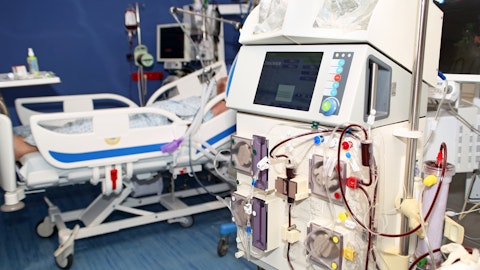Outset Medical, Inc. (NASDAQ:OM) Q3 2023 Earnings Call Transcript October 13, 2023
Operator: Thank you for standing by and welcome to Outset Medical’s Preliminary Third Quarter Results Conference Call. At this time, all participants are in listen-only mode. After the speakers’ presentation, there will be a question-and-answer session. [Operator Instructions] As a reminder today’s conference is being recorded. I would now like to hand the conference over to your host Mr. Jim Mazzola, Head of Investor Relations. Please go ahead, sir.
Jim Mazzola: Hey, good afternoon, everyone. The purpose of the call today is to discuss our preliminary results for the third quarter and provide updated guidance for 2023. I’m here with Leslie Trigg, Chair and Chief Executive Officer; and Nabeel Ahmed, Chief Financial Officer. We issued a news release and updated our investor presentation after market close today, both of which can be found on the Investor Relations pages of outsetmedical.com. This call is being recorded and will be archived in the Investors section of our website. It is our intent that all forward-looking statements made during today’s call be protected under the Private Securities Litigation Reform Act of 1995. Factors that cause actual results to differ materially from those forward-looking statements are discussed in Outset’s public filings with the SEC, including our latest annual and quarter reports. With that, I will now turn the call over to Leslie.
Leslie Trigg: Thanks, Jim and good afternoon. During today’s call, we will discuss our preliminary third quarter results, including the headwinds that impacted Q3 and that we expect will carry forward through the fourth quarter and into 2024. We will also discuss what has not changed, which includes Tablo’s wide and growing competitive moat, the clear economic advantages it delivers in the acute setting, and its ability to transform the patient and provider experience with home dialysis. Preliminary revenue for the third quarter was $30.4 million, a 9% increase over the third quarter of last year. The shortfall to the guidance we provided in August was driven by a larger than expected impact in the field from the recent FDA warning letter which served to elongate our sales cycle in several ways.
First, we observed more customers than we anticipated choosing to defer their Tablo console purchasing and installation, until TabloCart with prefiltration is available again. Second, we experienced a strong competitive response which served to create marketplace confusion, particularly regarding Tablo’s use in the ICU. From a regulatory perspective, we did submit our 510(k) for TabloCart with prefiltration and intend to work as expeditiously as possible with FDA to achieve clearance. As we said on our last call, we believe we have addressed the other aspects of the warning letter and look forward to closing it out upon receipt of the 510(k) clearance. We continue to believe the actions we have taken are the right steps toward resolving these observations and further strengthening our competitive position.
On a preliminary basis, non-GAAP gross margin over performed in the quarter, reaching 25.6%, more than nine percentage points over Q3 of last year, and sequential growth of more than three percentage points from Q2 of this year. Our cash position also remained strong, exiting the quarter at nearly $200 million. Turning to utilization and recurring revenue in the quarter, we continue to see consistent use of Tablo in the acute and home setting and strong revenue from software and service. Our preliminary results show treatment revenue increased more than 60% year-over-year, and core service and other revenue, excluding the impact of our HHS agreements in Q3 ’22, increased nearly 45% on a year-over-year basis. Looking ahead to Q4 while we have not seen deals fall out of our pipeline, and we continue to see customers responding to Tablo’s cost reduction value in the acute setting we can do now expect impact from the warning letter and our decision to pause TabloCart with prefiltration shipments to extend through at least the end of the year.
I am confident these are temporary issues that our sales team will overcome. But they did serve to slow us down and we will need additional time to get past it. Additionally, as the quarter progressed, we also started to observe an increasing number of hospitals and health systems in late Q3, deferring their purchase decisions in an environment of rising interest rates and more cautious capital spending. This deferral is serving to further elongate our sales cycle which we expect to continue into 2024. That said, customers are not turning away from Tablo and its value proposition and in fact, they continue to embrace Tablo’s proven financial and operational benefits and move towards the advantages of an insourced model. We saw a balanced quarter with roughly half of our console sales into the acute setting and half to home providers.
We continue to operate with a growing pipeline in both end markets and consistent console utilization. Further, we are seeing success with initiatives such as the Bridge Program, expanded physician education, and published cost reduction data, which are all having a positive impact in the acute setting. Taking the near term factors into account, we expect revenue for 2023 to be approximately $130 million. We will discuss our outlook for 2024 during our full Q3 earnings call in early November. Looking ahead to the longer term, we remain committed to the following pillars. First, achieving our 50% gross margin milestone. Second, burning less cash each year than the year before and third achieving profitability. On our November call, we will provide an update on our progress against these pillars.
We have a great deal of confidence in the long term opportunities for Tablo and in our ability to execute on them. We are on the front end of growth into large end markets. Our pipeline continues to expand and our value proposition remains compelling. Tablo remains highly differentiated with a growing competitive moat. And conventional dialysis care delivery models are inconsistent with how providers want to deliver care and with how patients want to live their lives. Across the board Tablo and Outset are uniquely well positioned to disrupt the status quo from the hospital to the home with long term structural tailwinds firmly intact. With that, we’ll open up the call for questions. We have a lot to cover. And I didn’t want to burden my prepared remarks reiterating views we’ve already shared publicly about recent GLP-1 data.
But having said that, I’m happy to cover that topic during Q&A if anybody has questions. And with that, operator, if you could please open the line.
See also 20 Best US Cities for Athletes and 20 Best E-Commerce Platforms for Small Businesses in 2023.
Q&A Session
Follow Outset Medical Inc. (NASDAQ:OM)
Follow Outset Medical Inc. (NASDAQ:OM)
Receive real-time insider trading and news alerts
Operator: Thank you. [Operator Instructions] Our first question comes from the line of Suraj Kalia. Your line is open. Hi, Mr. Suraj Kalia. Your line is open.
Suraj Kalia: Yeah. Hi, Leslie. Can you hear me all right?
Leslie Trigg: Yes.
Suraj Kalia: Perfect. So Leslie, in terms of TabloCart, and what specifically changed about the low-single digit impact to — how do you all quantify the impact now? And specifically on the acute side, if I recall correctly there was not supposed to be an impact. It seems like that too has flowed through. So maybe if you could just walk us through from Q2 to now, what suddenly has changed vis-à-vis TabloCart and CRRT? Thank you.
Leslie Trigg: Yeah, why don’t I — Nabeel, maybe I’ll provide some of the qualitative commentary, and then I’ll turn it over to you for the first part of Suraj’s question. Yeah, so a couple of thoughts on this then, Leslie, we felt very confident, actually in the beginning of Q3 and as we moved through the quarter, and we obviously always provide our very best view at the time based on the information and knowledge we have. We, as we said before, sales in our quarters are very backend weighted, similarly to many, if not most other capital equipment companies in the MedTech space. In this case, we did observe a significant number of deferrals during the last two weeks of the quarter. We did not see deals falling out of our pipeline.
We have not seen customers turning away from Tablo or the value proposition that we did see elongation of the sales cycle late in the quarter, causing some deals to just fall right over that line between Q3 and Q4. Again, that was due to really to several factors. One pertaining to some of the, sort of competitive activity around the warning letter. And also, I would say, a heightened capital spending climate and a rising interest rate environment, which as we’re seeing and hearing from health system executives is serving to sort of extend their internal decision making and the duration of their financial analyses around whether they’re going to purchase or whether they’re going to lease, and what makes sense to them at the time. So again, we did not change the fundamentals or the tailwinds of this business.
Our deal close extended, our deal pipeline did not disappear. But it has served to further elongate our sales cycle. And we do expect that to continue here through the fourth quarter and into 2024. But with that I’ll turn it over to Nabeel for any additional comments.
Nabeel Ahmed: Yeah. Hey, Suraj. Just to sort of bridge, kind of your question on — as we think about guidance where we were in Q2 relative to today, we — if you sort of take the chunks a little bit here, we said that roughly low-single digit million dollars was attributable to TabloCart with prefiltration itself. And then what we expected was that we would get some amount of deferrals, particularly in Q3 from customers who wanted to wait for TabloCart with prefiltration before taking their Tablo console itself. And indeed, we saw some of that, and that was a little bit more deferral than we anticipated. We also in Q3, we saw some of the noise, the marketplace noise related to the warning letter that carries forward into Q4. And then we’ll also start to see the impact of this capital spending. So that’s kind of the trend [ph] Suraj, if that makes sense.
Operator: Thank you. One moment please for our next question. Our next question comes from the line of Shagun Singh of RBC Capital Markets. Your line is open.
Shagun Singh: Great, thank you so much for taking the question. So I guess a couple from me. So on the capital side, can you just elaborate on these early signs that you’re seeing. What gives you the confidence that the capital orders are deferred and will not be canceled? And then with respect to this extended sales cycle, can you give us a look into by how many — how much has this been extended? How many months is it? Is it weeks, like how should we think about it? And then I have a couple of follow-ups?



